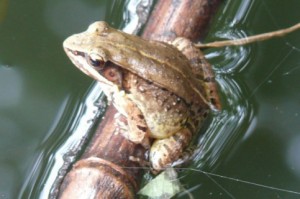Right ear advantage (REA) describes the tendency of animals to preferentially orient themselves in order to detect different types of auditory signals with different ears. It is believed that the orientation behaviors help improve efficiency of appropriate neural and behavioral responses to differing outside stimuli. In many animals, the right ear is preferentially used to process conspecific vocalizations, while the left year is favored for interspecific ad environmental stimuli. This phenomenon, however, had not been examined in anuran species, which rely heavily on vocal communications, and so Xue et al. (2014) examined orientation behaviors in Emei music frogs, Babina daunchina, in response to different types of auditory stimuli. Researchers predicted that the frogs would turn right to process conspecific calls, with stronger preference for more attractive calls, that neutral stimuli would elicit no turning preference, and that threatening stimuli would cause left turning behavior. The Emei music frog.
The Emei music frog.
The stimuli used were: highly sexually attractive conspecific calls (HSA), low attractive conspecific calls (LSA), screech calls produced by frogs upon predation, white noise, thunder, and silence. The test frogs were presented with recordings of the various stimuli, and their orientation behaviors were recorded.
Results showed a right ear preference in response to all of the stimuli except for the screech call. The strongest REA was displayed in response to HSA calls. This supports the idea that the right side is preferentially used to process positive conspecific calls, as well as showing a right side preference for more neutral stimuli, while the left side is preferred for fear-evoking stimuli. This is similar to responses seen in other animals, and supports the idea REA behavior is modulated by emotional responses to auditory stimuli.
Xue, Fei, et al. “The biological significance of acoustic stimuli determines ear preference in the music frog.” The Journal of experimental biology 218.5 (2015): 740-747.
